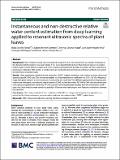Por favor, use este identificador para citar o enlazar a este item:
http://hdl.handle.net/10261/194245COMPARTIR / EXPORTAR:
 SHARE SHARE
 CORE
BASE CORE
BASE
|
|
| Visualizar otros formatos: MARC | Dublin Core | RDF | ORE | MODS | METS | DIDL | DATACITE | |

| Título: | Instantaneous and non-destructive relative water content estimation from deep learning applied to resonant ultrasonic spectra of plant leaves |
Autor: | Fariñas, María Dolores CSIC ORCID; Jimenez-Carretero, Daniel; Sancho-Knapik, Domingo; Peguero-Pina, José Javier; Gil-Pelegrín, Eustaquio CSIC ORCID ; Gómez Álvarez-Arenas, Tomás CSIC ORCID | Palabras clave: | RWC Ultrasounds Machine learning Plant leaves Irrigation NC-RUS |
Fecha de publicación: | 7-nov-2019 | Editor: | BioMed Central | Citación: | Plant Methods 15(1): 128 (2019) | Resumen: | [Background] Non-contact resonant ultrasound spectroscopy (NC-RUS) has been proven as a reliable technique for the dynamic determination of leaf water status. It has been already tested in more than 50 plant species. In parallel, relative water content (RWC) is highly used in the ecophysiological field to describe the degree of water saturation in plant leaves. Obtaining RWC implies a cumbersome and destructive process that can introduce artefacts and cannot be determined instantaneously. [Results] Here, we present a method for the estimation of RWC in plant leaves from non-contact resonant ultrasound spectroscopy (NC-RUS) data. This technique enables to collect transmission coefficient in a [0.15–1.6] MHz frequency range from plant leaves in a non-invasive, non-destructive and rapid way. Two different approaches for the proposed method are evaluated: convolutional neural networks (CNN) and random forest (RF). While CNN takes the entire ultrasonic spectra acquired from the leaves, RF only uses four relevant parameters resulted from the transmission coefficient data. Both methods were tested successfully in Viburnum tinus leaf samples with Pearson’s correlations between 0.92 and 0.84. [Conclusions] This study showed that the combination of NC-RUS technique with deep learning algorithms is a robust tool for the instantaneous, accurate and non-destructive determination of RWC in plant leaves. |
Versión del editor: | https://doi.org/10.1186/s13007-019-0511-z | URI: | http://hdl.handle.net/10261/194245 | DOI: | 10.1186/s13007-019-0511-z | ISSN: | 1746-4811 |
| Aparece en las colecciones: | (ITEFI) Artículos |
Ficheros en este ítem:
| Fichero | Descripción | Tamaño | Formato | |
|---|---|---|---|---|
| instantaneous_non-destructive_relative_water_content_estimation.pdf | 2,25 MB | Adobe PDF |  Visualizar/Abrir |
CORE Recommender
PubMed Central
Citations
9
checked on 14-abr-2024
SCOPUSTM
Citations
30
checked on 15-abr-2024
WEB OF SCIENCETM
Citations
24
checked on 25-feb-2024
Page view(s)
306
checked on 18-abr-2024
Download(s)
139
checked on 18-abr-2024

